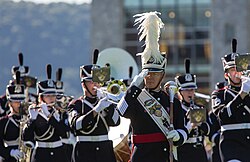
The United States Army has maintained multiple military bands in its over two centuries of service. These bands provide musical support for military camps and bases, military areas, and communities across the mainland United States and other territories such as Puerto Rico. United States military bands also serve in army units outside the country and in regions such as Western Europe or Eastern Asia. There are currently 87 army bands, which consists of 15 active duty regional bands, 13 reserve bands, 51 National Guard bands, and four premier bands. Many bandsmen are trained as part of Band of the Army School of Music at Virginia Beach before their assignment in these bands.








